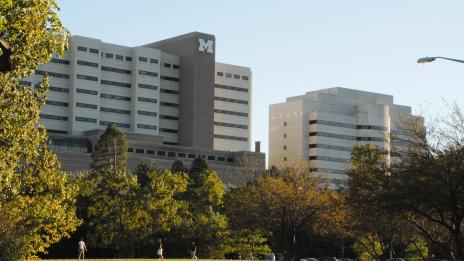By MargaretAnn Cross, Michigan Medicine | Photos by Scott C. Soderberg, Michigan Photography
Age-related macular degeneration (AMD) is the leading cause of irreversible blindness in people over 50. It is even more prevalent than Alzheimer’s disease, with 11 million people affected in the United States and 170 million globally. Between 70 percent and 90 percent of cases are the dry form of the disease, which causes gradual blurring of central vision. While successful therapies are in place for wet AMD, there are no standard treatment options for dry AMD.
An $11.5 million gift to the University of Michigan Health System’s W.K. Kellogg Eye Center aims to change that.
James Grosfeld, an investor, philanthropist, and the former chairman and CEO of PulteGroup, Inc., has made the gift to launch a pioneering research initiative. The effort, which represents one of the largest investments of talent and resources in the country targeted at developing effective treatments for dry AMD, will increase discovery, collaboration, and leadership in the field.
Specifically, Grosfeld’s gift will support:
- The establishment of two endowed professorships focused on dry AMD research
- Increased laboratory staffing to increase the pace of research
- Collaborative grants that will link dry AMD investigators with other experts at the Kellogg Eye Center and across U‑M to bring new techniques and approaches to bear on the disease
- A pluripotent stem cell facility to create cells for use in dry AMD-related research across disciplines
- Innovations in clinical research, including the collation of ophthalmic images to advance clinicians’ ability to track dry AMD progression
- Pilot funding for proof-of-concept experiments and research grants for trainees who seek to bring new ideas and perspectives to dry AMD research
“I am inspired by the passion, the commitment, and the ideas of the Kellogg Eye Center team,” Grosfeld says. “Increasing the speed and the breadth of discovery in dry AMD can make a significant difference in people’s lives.”
“It was a privilege to share with Mr. Grosfeld what a transformational investment in dry AMD research could mean, and we are very grateful for his enthusiasm, his generosity, and the belief he has placed in us,” says Paul P. Lee, M.D., J.D., the F. Bruce Fralick Professor and Chair of the U‑M Department of Ophthalmology and Visual Sciences and director of the Kellogg Eye Center.
Jason M. Miller, M.D., Ph.D., a physician-scientist who specializes in retinal diseases and dry AMD research, has been named the James Grosfeld Professor of Ophthalmology and Visual Sciences and will direct the initiative. Advancing understanding of dry AMD to identify pathways toward effective therapies has long been a goal for Miller, a third-generation ophthalmologist.
“I came to the Kellogg Eye Center to build a laboratory program for dry AMD, which impacts so many people. We have made several discoveries that have given us a clear direction toward potential treatments. At the same time, we have been building partnerships that will both accelerate our work and enable us to translate our efforts into clinical applications.”
AMD is marked by the accumulation of lipid-rich deposits in and around the retinal pigment epithelium (RPE), a part of the eye that keeps the retina’s light-sensitive photoreceptors alive. Miller’s research has led to a hypothesis that improving the RPE’s handling of lipid (fat) will slow the progression of dry AMD. His team is advancing understanding of how the RPE processes lipids. Their discoveries already are helping ophthalmologists make clinical determinations about care.
The new research initiative will create significant opportunities to collaborate with faculty across the Kellogg Eye Center, the University of Michigan, and with peers across the country, Miller says.
“The Kellogg Eye Center and the University of Michigan have world-class faculty studying problems as diverse as diabetes and heart disease. The research tools and methods they use, when applied to dry AMD, will spark new discoveries about this devastating disease.”
The initiative will also draw on U‑M expertise in ophthalmic imaging, drug development, and clinical trials.
“This gift is designed to have a maximum impact on research progress,” says Mark W. Johnson, M.D., a professor of ophthalmology and visual sciences and head of the retina division at Kellogg, which is one of the largest in the country. Johnson introduced Grosfeld to the dry AMD research taking place at Kellogg and will serve on an advisory board overseeing the initiative.
“In catalyzing work across disciplines, we are enabling the creative application of a wide range of scientific techniques and approaches to the challenges of dry AMD,” says Marschall S. Runge, M.D., Ph.D., dean of the University of Michigan Medical School, executive vice president for medical affairs, and CEO of Michigan Medicine. “Mr. Grosfeld’s visionary support will enable us to make important advances toward saving sight today and will create a legacy of sight-saving achievement.”

